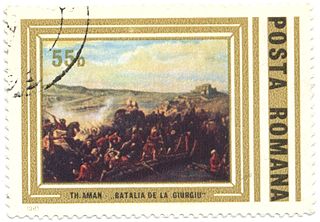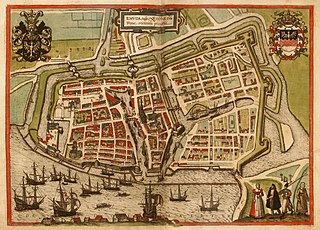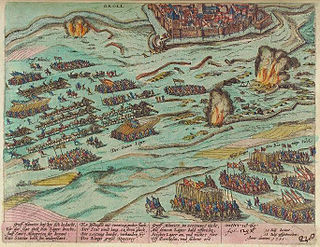 W
WOn 16 February 1595, a Gaelic Irish force assaulted and captured the English-held Blackwater Fort at Blackwatertown in County Armagh. The Irish were led by Art MacBaron O'Neill, brother of Hugh O'Neill, Earl of Tyrone, and marked Tyrone's break with the English Crown as he openly waged war against the English forces in Ireland.
 W
WThe Battle of Călugăreni was one of the most important battles in the history of early modern Romania. It took place on 23 August 1595 between the Wallachian army led by Michael the Brave and the Ottoman army led by Koca Sinan Pasha. It was part of the Long War, fought between Christian and Ottoman forces at the end of the 16th – beginning of the 17th centuries.
 W
WThe Battle of Giurgiu took place on 27–30 October 1595. It was part of the Long War (1591/1593–1606), a border conflict between the Habsburg Monarchy and the Ottoman Empire over Balkan territories.
 W
WThe Battle of San Juan (1595) was a Spanish victory during the Anglo–Spanish War. This war broke out in 1585 and was fought not only in the European theatre but in Spain's American colonies. After emerging from six years of disgrace following the resounding defeat of the English Armada at Lisbon in 1589, Francis Drake embarked on a long and disastrous campaign against Hispanic America, suffering several consecutive defeats there. On 22 November 1595 Drake and John Hawkins tried to invade San Juan with 27 ships and 2,500 men. After failing to be able to land at the Ensenada del Escambron on the eastern end of San Juan Islet, he attempted to sail into San Juan Bay with the intention of sacking the city. Unable to capture the island, following the death of his comrade, John Hawkins, Drake abandoned San Juan, and set sail for Panama where he died from disease and received a burial at sea after failing to establish an English settlement in America.
 W
WThe Burmese–Siamese War (1593–1600) was the war fought between the Toungoo Dynasty of Burma and the Ayutthaya Kingdom of Siam. The war was the culmination of Siam's move towards independence following subjugation after the Burmese–Siamese War (1584–1593). The war ended with a victory by Siam, which seized the cities of Tavoy and Tenasserim, and laid siege to two major cities of the Toungoo Dynasty.
 W
WThe Capture of Recife also known as James Lancaster's 1595 Expedition or Lancaster's Pernambucan expedition was an English military expedition during the Anglo–Spanish War in which the primary objective was the capture of the town and port of Recife in Pernambuco in the Portuguese colony of Brazil in April 1595. An English expedition of ships led by James Lancaster sailed via the Atlantic capturing numerous prizes before he captured Recife. He held the place for nearly a month and then proceeded to defeat a number of Portuguese counterattacks before leaving. The booty captured was substantial, Lancaster chartered Dutch and French ships that were also present there thus making the expedition a military and financial success.
 W
WThe Battle of Cecora took place on October 19–20, 1595, during an expedition of Jan Zamoyski, of the Polish-Lithuanian Commonwealth, to Moldavia, as part of the Moldavian Magnate Wars.
 W
WThe Battle of Clontibret was fought in County Monaghan in May 1595, during the Nine Years' War in Ireland. A column of 1,750 English troops led by Henry Bagenal was ambushed near Clontibret by a larger Gaelic Irish army led by Hugh O'Neill, Earl of Tyrone. The English column had been sent to relieve the besieged English garrison at Monaghan Castle. The English suffered very heavy losses, but a suicidal cavalry charge apparently saved it from destruction. The Irish victory shocked the English and was their first severe setback during the war.
 W
WThe Raid on Mounts Bay also known as the Spanish attack on Mounts Bay was a Spanish raid on Cornwall, England, that took place between 2 and 4 August 1595 during the Anglo-Spanish war of 1585-1604. It was conducted by a Spanish naval squadron led by Carlos de Amésquita on patrol from Brittany, France. The Spanish made landfall in Mount's Bay then sacked and burned Newlyn, Mousehole, Penzance, and Paul, beating a militia force under Francis Godolphin in the process.
 W
WThe Emden Revolution of 18 March 1595 marked the beginning of the status of Emden as a quasi-autonomous city-state.
 W
WThe Battle of the Lippe was a cavalry action fought on 2 September 1595 on the banks of the Lippe river, in Germany, between a corps of Spanish cavalry led by Juan de Córdoba and a corps of Dutch cavalry, supported by English troops, led by Philip of Nassau. The Dutch statholder Maurice of Nassau, taking advantage of the fact that the bulk of the Spanish army was busied in operations in France, besieged the town of Groenlo in Gelderland, but the elderly governor of the citadel of Antwerp, Cristóbal de Mondragón, organized a relief army and forced Maurice to lift the siege. Mondragón next moved to Wesel, positioning his troops on the southern bank of the Lippe river to cover Rheinberg from a Dutch attack. Maurice aimed then, relying on his superior army, to entice Mondragón into a pitched battle, planning to use an ambush to draw the Spanish army into a trap. However, the plan was discovered by the Spanish commander, who organized a counter-ambush.
 W
WThe Preston–Somers expedition, or the Capture of Caracas, was a series of military actions that took place from late May till the end of July 1595 during the Anglo-Spanish War. The English expedition headed by George Somers and Amyas Preston sailed to the Spanish Main initially intending to support Sir Walter Raleigh's expedition which set out at the same time.
 W
WRaleigh's El Dorado expedition, also known as Raleigh's first voyage to Guiana, was an English military and exploratory expedition led by Sir Walter Raleigh that took place during the Anglo-Spanish War in 1595. The expedition set out in February 1595 to explore the Orinoco River on the northeast tip of South America in an attempt to find the fabled city of El Dorado.
 W
WThe Siege of Doullens, also known as the Spanish capture of Doullens or the Storming of Doullens, took place between 14 and 31 July 1595, as part of the Franco-Spanish War (1595-1598), in the context of the French Wars of Religion. After ten days of siege, on 24 July, the combined forces of Henri de La Tour d'Auvergne, Duke of Bouillon, André de Brancas, Amiral de Villars, and François d'Orléans-Longueville, tried to relieve the city, but were severely defeated by the Spanish forces led by Don Pedro Henríquez de Acevedo, Count of Fuentes, and Don Carlos Coloma. Villars was taken prisoner and executed, and the Duke of Bouillon fled to Amiens with the rest of the French army. Finally, a few days after, on 31 July, the Spanish troops stormed Doullens. The Spaniards killed everybody in the city, military and civilians alike, shouting "Remember Ham" (Spanish: "Recordad Ham"), in retaliation for the massacre against the Spanish garrison of Ham by the French and Protestant soldiers under Bouillon's orders.
 W
WThe Siege of Enniskillen took place at Enniskillen in Fermanagh, Ireland, in 1594 and 1595, during the Nine Years' War. In February 1594, the English had captured Enniskillen Castle from the Irish after a waterborne assault and massacred the defenders after they surrendered. From May 1594, an Irish army under Hugh Maguire and Cormac MacBaron O'Neill besieged the English garrison in the castle, and in August they defeated an English relief force. A second relief force was allowed to resupply the garrison, but the castle remained cut off. Eventually, in May 1595, the English garrison surrendered to the Irish and were then executed.
 W
WThe Siege of Grol or Groenlo in 1595 was a siege of Groenlo by States forces under Maurice of Nassau during the Eighty Years' War in an attempt to capture it from the Spanish Empire. It lasted from 14 to 24 July 1595, ending with the arrival of a Spanish relief force under Cristóbal de Mondragón and Maurice's retreat. Two years later, in 1597, Maurice returned to carry out another Siege of Groenlo. Both these sieges formed part of what would later be called the Ten Glorious Years.
 W
WThe Siege of Huy of 1595, also known as the Assault of Huy, was a Spanish victory that took place between 7 and 20 March 1595, at Huy, Archbishopric of Liège, Low Countries, as part of the Eighty Years' War, the French Wars of Religion, and the Anglo-Spanish War (1585–1604).